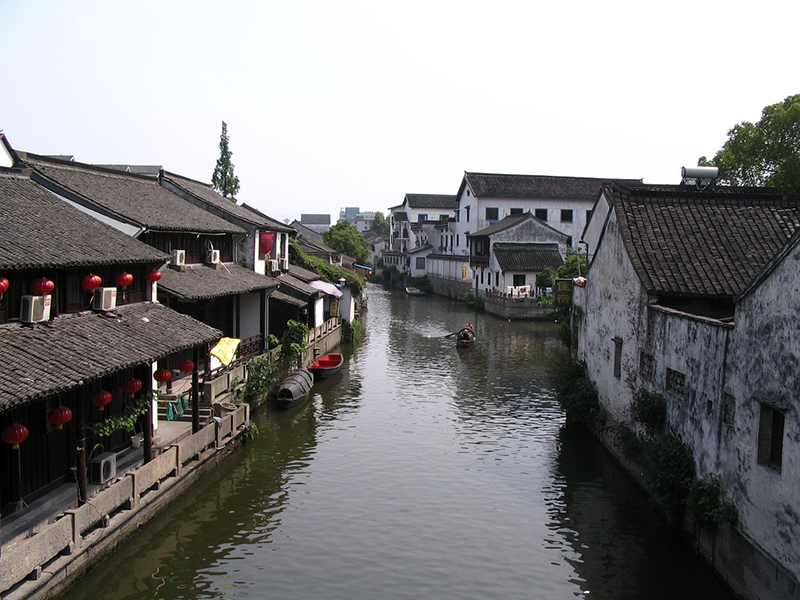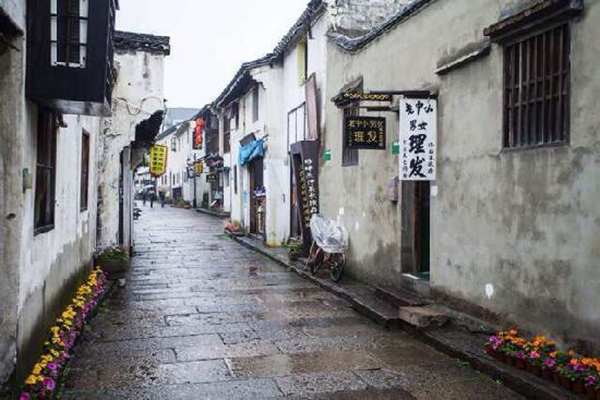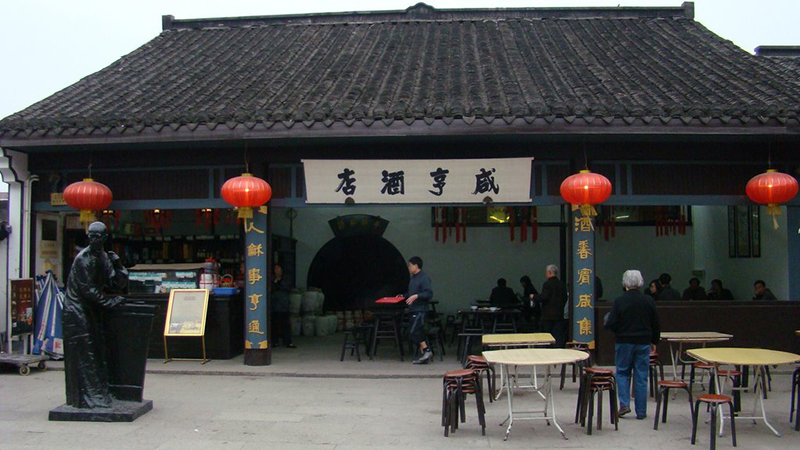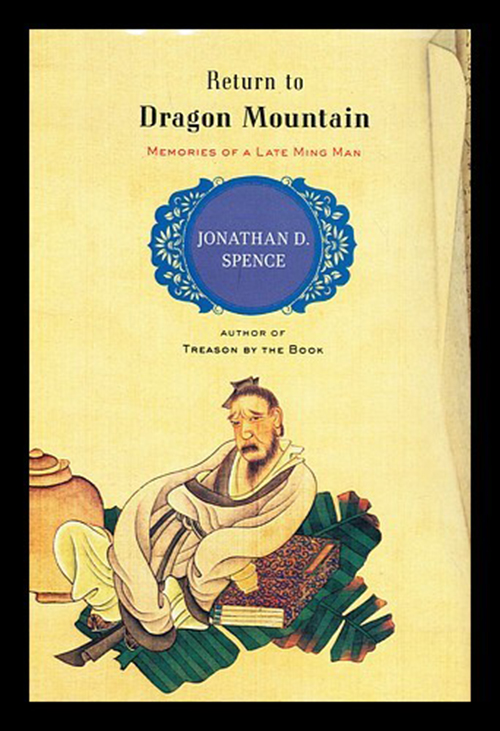Shaoxing is a magical place for me. There are a few others in China–Qingdao, Moganshan, and Xiangshan just outside Beijing. These aren’t obscure places. Many people have been there, but maybe they don’t see them the way I do. I have been to each of them many times and even after years of separation I don’t need any map to get around. Each is a separate and important thread of my China story. Previously I have written about Xiangshan. Now I want to talk about Shaoxing.
 I first went to Shaoxing in the spring of 2008. At that time I was in the Chinese habit of taking a “chunyou” (春游) every year–a spring travel. This custom started in ancient times as a part of Qingming Festival when families went to the countryside to tend the graves of ancestors. Then it became a popular thing for students to do as the school year came to an end. Nowadays even companies organize them.
I first went to Shaoxing in the spring of 2008. At that time I was in the Chinese habit of taking a “chunyou” (春游) every year–a spring travel. This custom started in ancient times as a part of Qingming Festival when families went to the countryside to tend the graves of ancestors. Then it became a popular thing for students to do as the school year came to an end. Nowadays even companies organize them.
I was also at that time in the habit of reading Chinese travel guides. I have a whole shelf of them now, province by province, theme by theme. One my favorites was a detailed guide to China’s coast, from Dalian to Sanya. Through it I disovered quite a few interesting port towns, islands and untouched beaches. Another prized one was a guide to Zhejiang. In it was captured a number of small towns and lost temples and sacred mountains. There were more than a few pages devoted to Shaoxing.
First, a word about Chinese travel guides. They are detailed, moreso than the Western ones by several orders of magnitude. Over their 5,000 years of history the Chinese have tagged, labeled and categorized all the sights–historical and natural–that exist around them. They may not provide much insight about the significance of these sights, but few if any are left unrecorded.
Most foreigners will have heard of Shaoxing–it’s where the best huangjiu (yellow wine) comes from. This strong, sweetish alcohol is made from rice and is often served heated. It’s quite specific to the Jiangnan region (the Yangtze River Delta). I think it’s a matter of time before huangjiu develops a following among foreigners–it’s good stuff, better than baijiu, though lacking the sophistication of grape varietals. Nonetheless there is enough history, tradition, craftsmanship and diversity of taste for connoiseurship to develop. Plus, it’s the perfect antidote to a cold and rainy day in Shanghai. I like to heat it with a few bits of ginger and orange peel. Anyway, I went to Shaoxing for the wine, but I found a lot more.
Shaoxing is a water town–like Suzhou–though it lacks Suzhou’s classical gardens and UNESCO mojo. Canals run through it and around it, an ancient moat protecting city walls which have long since disappeared. You can take a boat around the city at night. On a fine evening it’s a lovely experience. Shaoxing draws its share of tourists, but nothing like Suzhou.
I arrived at Shaoxing Zhan in the late afternoon and had an immediately favorable impression. Outside the station I found myself looking over a pleasant open square. I noticed the difference immediately–no fences or railings. Every other train station in China has miles of railing which separates the square from the city beyond. Then usually there is more railing separating taxi lanes and bus lanes from the square to keep pedestrians out of the way. And then there is more railing to separate the crowds into long, semi-orderly queues entering into the station itself. The upshot is there’s just no way to walk a straight line into a Chinese train station. You’re herded through a series of gates and fenced off areas like cattle. All this is by design. Modern China has perfected the art of making humans feel like cattle. Shaoxing Zhan is an exception. In front of the station is a public square and then a road and then a canal–no fences to be seen. It makes a huge difference. It feels like a train station in a small European town like Bordeaux.
Shaoxing Zhan is where the old, slow, green trains stop. These days, though, most people stop at Shaoxing Bei which is where the gaotie pulls in on its flybys. That’s something else we have lost in our rush to get places faster–the city arrival. Before the gaotie, it used to be that your train would chug to s stop, cough out one final groan of steam, and you would step out of the station into the thrum of the city. Remember how it used to be pulling into Hangzhou Zhan? You were a stone’s throw from West Lake. And when was the last time you arrived at Shanghai Zhan, diving into the multitude of humanity around Hanzhong Lu, engulfed in the energy of the city? Beijing Zhan was the same. You were a few blocks from Tiananmen, within site of the old City Wall, ready for action.
The gaotie–for all its other conveniences–has taken that away. Now you are dumped off at sidings in the middle of nowhere, at the mercy of heiche cab drivers, if there are any cabs at all. You end up adding a half hour to your trip out to Hongqiao to catch the train and another another half an hour getting from Hangzhou Dong or Nanjing Nan or Ningbo Bei into the city which pretty much wipes out the “gains” from the high-speed train. Well maybe not entirely. It used to take just over three hours to get to Shaoxing from Shanghai. Now it’s less than an hour and a half.
Shaoxing Zhan was my favorite city station. Quiet and sleepy, it set the tone for any Shaoxing visit.
It was early evening when I stepped out of the station. The sun was dipping low, bathing everything in a golden radiance. I walked to my hotel a few blocks away–a Rujia. After throwing down my stuff I went for a stroll in the old quarter not far away and ended up at the foot of Ji Shan, a hill in the middle of a park. I found a restaurant, one of those bustling affairs that serves local dishes, with fuwuyuans running around and a lot of loud chatter. People toasted each other as empty bottles piled up.
Foreigners are not common in Shaoxing and so the arrival of one who spoke Chinese caused a minor uproar. They made a fuss over me. Somehow I didn’t mind. It wasn’t the creepy voyeuristic fuss you get in a lot of other places, but a friendly, booze-fueled warmth. Anyway, I was in full chunyou mode and glad for the conversation. In fact, that was one of the primary beauties of the chunyou–meeting random people and talking to them. It was an opportunity to re-balance the scales that further and further tilt toward solitude the longer I live in China.
I ended up having a long conversation with one of the waitresses there, a small thin thing from Luoyang. She had bangs that nearly covered her eyes. Her name was Han Lili. She was 20 years old and had come to Shaoxing to work. Her parents were back in Luoyang and worried about her. We exchanged phone numbers and for several years after that kept in touch. Every time I went back to Shaoxing I would always take a meal at that restaurant. The last time I went to Shaoxing, in 2010, Han Lili was gone. A change of phones had lost me her number. I wonder what she is doing now. I wonder what her life is like. I wonder if she ended up following my advice to train at the Shaolin Temple and become China’s first martial arts waitress master.
After a good meal I went in search of Cangqiao–a “laojie” Old Street running next to a canal recommended by the guidebook. The architecture was preserved, the way of life too. The vibe of history was strong enough not to be completely defeated by the shops selling knit baby shoes, silk blouses, fake jade trinkets, cheap “ancient style” folding fans, and other “techan” (特产). There were plenty of restaurants and tea houses too, though not many were open. But I found one and got what I came for–a bowl of huangjiu served on a second floor balcony overlooking the dark waters of the canal below. A few red lanterns hung from the white, age-stained walls, their light reflecting in the water below. Since then I have found many better places to drink huangjiu, but none stand out in memory like that one where I realized a dream of myself and my place in this Chinese world.
 The next day I went exploring the city. There are a number of sites to see such as the Shen Yuan garden of the poet Lu You and the Xiaofang Ta pagoda in the central square, but what what struck me most was the people–fashionable, sophisticated and confident, much moreso than I expected at least for a city without an international-brand hotel and only a single Starbucks. The women dressed well and did not pay me the least bit of attention. On a later trip I found out why they were so fashionable–Shaoxing and the surrounding area is a major center of textile production in China. A group of Iranians told me this. They were there on business, checking in on their Persian carpet making factory.
The next day I went exploring the city. There are a number of sites to see such as the Shen Yuan garden of the poet Lu You and the Xiaofang Ta pagoda in the central square, but what what struck me most was the people–fashionable, sophisticated and confident, much moreso than I expected at least for a city without an international-brand hotel and only a single Starbucks. The women dressed well and did not pay me the least bit of attention. On a later trip I found out why they were so fashionable–Shaoxing and the surrounding area is a major center of textile production in China. A group of Iranians told me this. They were there on business, checking in on their Persian carpet making factory.
Shaoxing, by the way, still has no major international chain hotels. Not a Marriott, not a Westin. Anji has a Sheraton for chrissake. And on my most recent trip I saw only one Starbucks–in a mall that had opened only a month ago. The one which I had seen on my first trip had closed. I have a feeling that this is not necessarily an accident, that it’s a way of holding back the tide which makes every place in China converge to the same phenotype. Shaoxing still manages to feel like a small town with its own character.
I met one other person on that first trip to Shaoxing, someone I still keep in touch with–Sam Wenyan. This Sam is actually Samantha and her Chinese name is Wenyan. The way I met her was completely random. My second to last day in Shaoxing I went a few kilometers southeast of the city to Kuaiji Shan. My guidebook said there was a monastery at the top worth seeing. I took a cab there, passing hills festooned with graves on the way. The monastery was worth the hike and the view of the city and the surrounding flats was amazing.
 On the way back to town spur of the moment I decided to take a bus. A stop later a foreigner got on and we started talking. He was teaching at the Zhejiang Foreign Languages College. He asked me if I wanted to meet up later. He said he had some students who wanted to practice their English. That sounded alright–I had nothing better to do.
On the way back to town spur of the moment I decided to take a bus. A stop later a foreigner got on and we started talking. He was teaching at the Zhejiang Foreign Languages College. He asked me if I wanted to meet up later. He said he had some students who wanted to practice their English. That sounded alright–I had nothing better to do.
We met at a bar downtown. It wasn’t really a bar, but one of those coffee shop lounge things which also somehow also served beefsteak and pineapple pizza. You used to find these kinds of places a lot all over China in the ’90s before people developed genuine bar-going habits but still needed places away from families to meet and flirt. It was on the second floor of a building, hidden among cheap neons. The students were late.
We got to talking. The guy, Australian, was in his 50s. He was direct about the fact he enjoyed seducing his students. Three of them were supposed to meet us–all girls. In cities like Shaoxing if you meet a foreigner teaching English at a university he is either a recent uni graduate, a missionary, or 50-year-old divorced dude trying to live the dream one last time before kicking off. It’s hard to hold that against a guy.
The students showed up. They had already eaten. I looked at the guy–he just shrugged. Students are notoriously unreliable–skittish like hummingbirds. Sam was one of them. I don’t remember the other two.
They were pretty impressed when I started yapping away in Chinese to them. They has never seen such a thing in real life. I was like one of those oddball laowai TV characters come to life. We ended up talking for awhile and then going out for fried noodles on the street where some tents were set up on the sidewalk. Me and the Australian guy drank beer as I told them exaggerations and lies about life in Shanghai and Beijing. The Australian suggested we go to a nightclub around the corner. To my amazement the girls agreed. It was going to be “tebie high” (特别) as the Chinese would say.
Nothing came of it, though for some reason I did get Sam’s phone number. Sam was good looking back then and over the years became a beautiful woman. This is a thing about Chinese girls. They may mature faster than the boys, but a Chinese girl doesn’t become a woman until well into her 20s, after she figures out her own style and personality. Girls like Sam were diamonds in the rough. She just got married last year and sent me photos of the wedding. She was gorgeous in her white gown. Now she runs a few business in the Hangzhou area.
Over the years I have made several more visits to Shaoxing, making more discoveries each time, building the picture, adding depth and shadow. There is the exquisite ambiance of night in Lu You’s Shen Yuan garden when the opera troupe and the guqin players perform. There’s the ancient academy on Ji Shan with the strange painting of a Qing scholar–his body done in classic style, his head in modernist realism like a stern pontiff. There’s the Xianheng Jiudian–one of my favorite restaurants in China–with its cuipi chicken and bowls of huangjiu.
 It was on that trip that I also discovered what would become one of my favorite places in China–Lu Xun’s guju (故居) and the Baicao Jingshe (百草静舍) inside it which inspired his most lyrical work Wild Grass. There’s actually not much there that’s remarkable except, in the back, near the canal, there is a hidden tea house where you can get a pot of longjing for a few kuai and sip it while you sit in one of the comfortable bamboo chairs which overlook the canal. On the other side of the canal not 5 meters away locals stroll back and forth carrying the shopping, pushing a bike, or leading a small child.
It was on that trip that I also discovered what would become one of my favorite places in China–Lu Xun’s guju (故居) and the Baicao Jingshe (百草静舍) inside it which inspired his most lyrical work Wild Grass. There’s actually not much there that’s remarkable except, in the back, near the canal, there is a hidden tea house where you can get a pot of longjing for a few kuai and sip it while you sit in one of the comfortable bamboo chairs which overlook the canal. On the other side of the canal not 5 meters away locals stroll back and forth carrying the shopping, pushing a bike, or leading a small child.
 There’s no time limit, there’s no rush. There is nothing except you and the water. You can pick up a bilingual copy of Wild Grass at the gift shop and flip through it while you sit. It’s quite a nice place for that particularly literary kind of reflection that fills you with longing and wild imaginings and spreads out endlessly in all directions. The spell is broken as soon as you leave, but it’s always there if you need it. I might add that entrance to Lu Xun’s guju is free. There are precious few places anymore in China where inspiration comes without cost.
There’s no time limit, there’s no rush. There is nothing except you and the water. You can pick up a bilingual copy of Wild Grass at the gift shop and flip through it while you sit. It’s quite a nice place for that particularly literary kind of reflection that fills you with longing and wild imaginings and spreads out endlessly in all directions. The spell is broken as soon as you leave, but it’s always there if you need it. I might add that entrance to Lu Xun’s guju is free. There are precious few places anymore in China where inspiration comes without cost.
And that’s the thing about Shaoxing, it’s a very literary place. Cai Yuanpei–the first president of Peking University–was from there. Yu Hua is from there. Wang Xizhi–a giant of Chinese calligraphy–was from there. His ancestral home has been turned into a temple. All this I knew. But I didn’t know the story of Zhang Dai until a copy of Jonathan Spence’s book Return to Dragon Mountain: Memoirs of a Late Ming Man came into my hands recently.
 Zhang Dai was scion of an illustrious Shaoxing family. They were wealthy landowners and had several generations of scholar-officials in the family. Over the generations they had become connoisseurs, art collectors, patrons, writers, historians, aesthetes, wastrals. They were in politics at every level. Zhang Dai had the fortune (good or bad) to live through the fall of the Ming Dynasty and well into the Qing. The book that made his legacy was a volume called Dream Recollections of Tao’an–a collection of snapshots of his life, or how he wanted to remember it.
Zhang Dai was scion of an illustrious Shaoxing family. They were wealthy landowners and had several generations of scholar-officials in the family. Over the generations they had become connoisseurs, art collectors, patrons, writers, historians, aesthetes, wastrals. They were in politics at every level. Zhang Dai had the fortune (good or bad) to live through the fall of the Ming Dynasty and well into the Qing. The book that made his legacy was a volume called Dream Recollections of Tao’an–a collection of snapshots of his life, or how he wanted to remember it.
Zhang’s ancestors had all served the Ming and when the Ming fell Zhang’s world fell with it. He lost his fortune and was deserted by his servants. He hid in the rugged hills south of Shaoxing for three years disguised as a commoner. At some point the heat relented enough that he was able to return to Shaoxing. But his estates were gone. He took up a patch of land on the slope of Dragon Mountain and lived out his remaining years there as a farmer, hence the name of Spence’s book.
Dream Recollections is a slim volume, especially compared to his other works which included a comprehensive history of the Ming Dynasty. It collected together a series of essays which Zhang himself considered to be nothing more than “digressions”–casual recollections, lively portraits, philosophical banter, random asides–all seen through the prism of a life disrupted. He emerges in Spence’s book as a tragic, comical, deeply real character.
In my trips to Shaoxing I had never heard of a Dragon Mountain. It wasn’t in the guidebooks, but Spence writes very clearly that the mountain was within Shaoxing’s former city walls. I remembered Ji Shan and the “academy” with its inscription: “zhexue yuanyuan” (哲学渊源)–the fount of philosophy. I decided to take another trip to see if I couldn’t find the place where Zhang Dai lived out his final days trying to put his life back together like shards of a broken vase. This time I booked myself into the Shaoxing Fandian. I had always wanted to stay there. It was built in the 1950s in the classical style–a collection of white buildings with black trim scattered on a campus at the foot of Fu Shan Park. A canal runs in front of it full of jade green water spanned by ancient stone bridges.
 I arrived at night. The next morning quite early I walked to Cangqiao, which is just next to the Shaoxing Fandian. There I saw an old rusty street sign nailed to a wooden post: “Long Shan Houjie.” Fu Shan was Zhang Dai’s Dragon Mountain, not Ji Shan.
I arrived at night. The next morning quite early I walked to Cangqiao, which is just next to the Shaoxing Fandian. There I saw an old rusty street sign nailed to a wooden post: “Long Shan Houjie.” Fu Shan was Zhang Dai’s Dragon Mountain, not Ji Shan.
I began to hike, following a mix of paved walkway and dirt trails, until I reached the pagoda on top. The plaque told me that it dated back to pre-Tang China when the area was known as the Kingdom of Yue. Lower down I encountered a few calligraphied stone faces dating to the Tang and Song periods. I descended the back side of the hill past the Shaoxing Orchid Growers Society until I came to the palace of the ancient King of Yue. It’s an impressive structure even rebuilt, empty save myself in the deep spring. A hall sits on top of a double terraced stone wall covered entirely by plants. Moss coats a stone table. A trickle of water seeps from the rock into a large square-cut basin. Ancient cypresses twist in agony. Birds twitter. Nothing about Zhang Dai anywhere.
 I followed Cangqiao back towards the hotel and sat for an hour in the Yanyu Tea House with a cup of tieguanyin. I had a good view of the canal. I noted that it would be several months before the willow trees budded. I tried to imagine I was sitting in the spot where Zhang Dai lived out his final days. But there was nothing in it.
I followed Cangqiao back towards the hotel and sat for an hour in the Yanyu Tea House with a cup of tieguanyin. I had a good view of the canal. I noted that it would be several months before the willow trees budded. I tried to imagine I was sitting in the spot where Zhang Dai lived out his final days. But there was nothing in it.
All I was left with was me.


